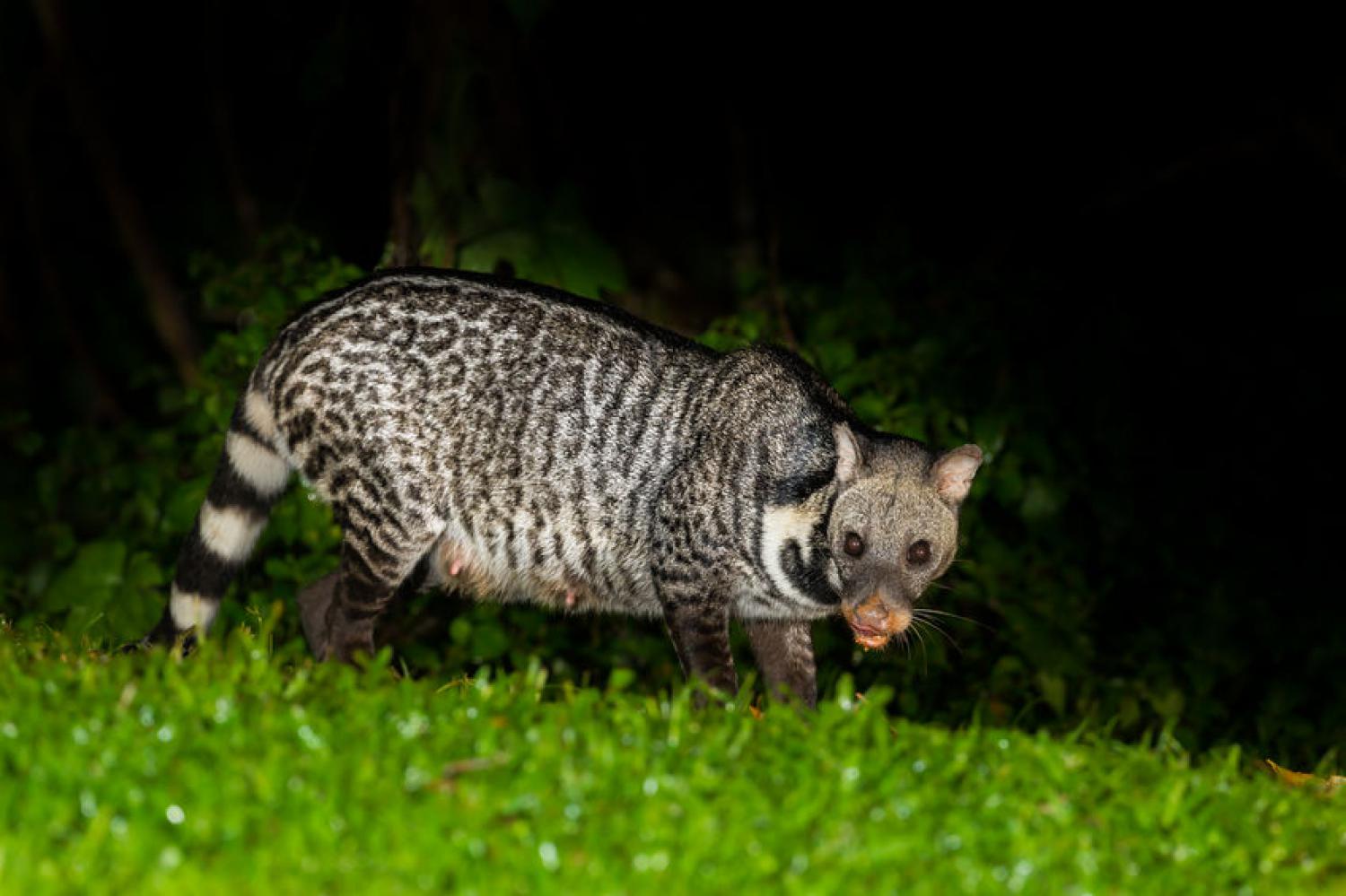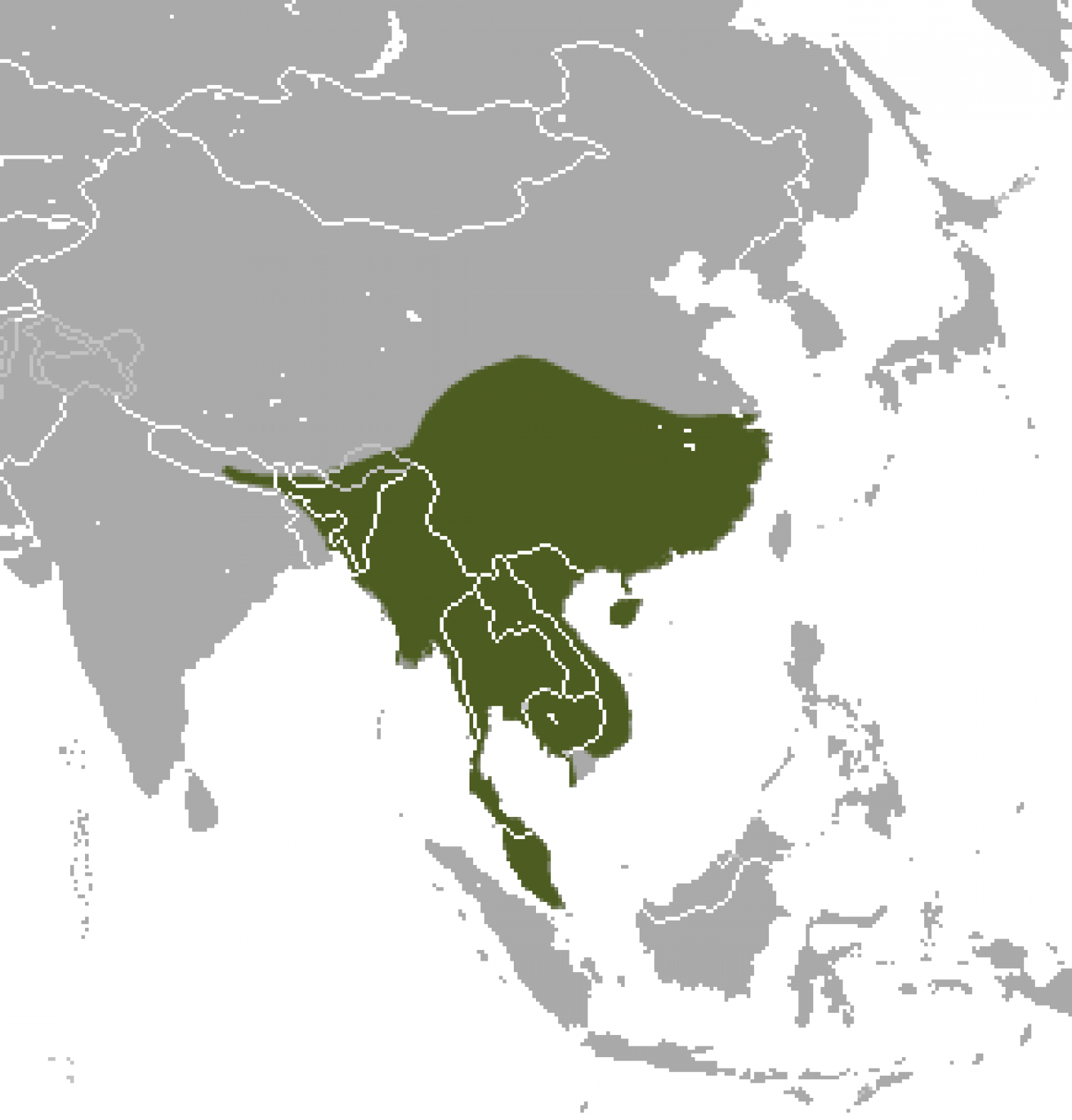Species of Thailand
Large Indian civet
Viverra zibetha
Carolus Linnaeus, 1758
In Thai: ชะมดแผงหางปล้อง
The large Indian civet (Viverra zibetha) is a civet native to South and Southeast Asia. It is listed as Near Threatened by IUCN since 2008, mainly because of trapping-driven declines in heavily hunted and fragmented areas, notably in China, and the heavy trade as wild meat.
Characteristics
Large Indian civets are generally grizzled greyish brown, with white and black bars along the neck, a white muzzle, and usually two white stripes and three black stripes on the tail. The hair on the back is longer. The claws are retractable, and there is hair in between the paw pads. They are almost as big as a binturong and an African civet, with a head-and-body length ranging from 50 to 95 cm and 38 to 59 cm long tail. The hind foot measures 9 to 14.5 cm. Their weight ranges from 3.4 to 9.2 kg.
Distribution and habitat
The large Indian civet ranges from Nepal, northeast India, Bhutan, Bangladesh to Myanmar, Thailand, the Malay peninsula and Singapore to Cambodia, Laos, Vietnam and China.
Distribution of subspecies
Six subspecies have been proposed but a taxonomic revision is needed. The validity of the species Viverra tainguensis described in 1997 by Sokolov, Rozhnov and Pham Chong from Tainguen Plateau in Gialai Province in Vietnam has been seriously questioned, and it is now generally considered a synonym of V. zibetha.
(See list of recognized species further down)
Ecology and behaviour
Large Indian civets are solitary and nocturnal. They spend most of their time on the ground, and are agile climbers. During the day, they sleep in burrows that have been dug and abandoned by other animals. They are territorial and mark their territories with excretions from their anal glands. Their territory ranges from 1.7 to 5.4 km2.
Large Indian civets are mostly carnivorous. They eat birds, frogs, snakes, small mammals, eggs, crabs, and fish, but also fruit and roots.
Reproduction
Females breed at any time of the year, and generally have two litters a year. A litter usually consists of four young. They are born in a hole in the ground or in dense vegetation. They open their eyes at 10 days and are weaned at one month of age.
Conservation
Viverra zibetha is totally protected in Malaysia under the Wildlife Protection Act of 1972 and listed on Category II of the China Wildlife Protection Law. China listed it as ‘Endangered’ under criteria A2acd, and it is a class II protected State species (due to trapping for food and scent glands). It is protected in Thailand, Vietnam and Myanmar. It is found in several protected areas throughout its range. The population of India is listed on CITES Appendix III.
In Hong Kong, it is a protected species under the Wild Animals Protection Ordinance Cap 170, though it has not been recorded in a natural state in Hong Kong since the 1970s, and is considered extirpated.
Local names
In Assamese it is called Gendera or Johamol.
In Bengali it is called Baghdas, Bham or Bham Biral and Gandho Gokul or Khatas.
Biral= cat, Gandho= smell or scent. Gokul= the place of Lord Krishna (Govinda). In Bengal there is a delicate variety of sweet and pleasant smelling rice known as Govindabhog rice (the rice which is offered to Lord Govinda). The secretion from prene gland of civet cat smells like that variety of rice, so it is often called as "Gandho Gokul".
In Malay language it is called Musang kasturi (musang = fox, kasturi = musk), due to its musky smell.
In Thai, it is called chamot phaeng hang plong (ชะมดแผงหางปล้อง; ; lit. "circular tailed/maned genet")
In Lao, it is called ngen phaeng hang kan (ເຫງັນແຜງຫາງກ່ານ; ; lit. "stripe-tailed/maned civet")
This article uses material from Wikipedia released under the Creative Commons Attribution-Share-Alike Licence 3.0. Eventual photos shown in this page may or may not be from Wikipedia, please see the license details for photos in photo by-lines.
Scientific classification
- Kingdom
- Animalia
- Phylum
- Chordata
- Class
- Mammalia
- Order
- Carnivora
- Family
- Viverridae
- Genus
- Viverra
- Species
- Viverra zibetha
Common names
- German:
- Indische Zibetkatze
- Indien-Zibetkatze
- Große Indische Zibetkatze
- Asiatische Zibetkatze
- Spanish:
- Gran civeta india
- Gran civeta oriental
- French: Grande civette de l'Inde
- Italian: Grande civetta indiana
- Dutch: Indische civetkat
- Russian:
- Азиатская цивета
- большая цивета
- Swedish: Indisk sibetkatt
- Thai: ชะมดแผงหางปล้อง
Subspecies
Viverra zibetha ashtoni, Robert Swinhoe, 1864
Range: China
Viverra zibetha hainana, Wang & Xu
Common name: 1983
Viverra zibetha picta, Robert Charles Wroughton, 1915
Range: Assam and northern Myanmar to Indochina
Viverra zibetha pruinosa, Robert Charles Wroughton, 1917
Range: Tenasserim and Peninsular Malaysia
Viverra zibetha zibetha, Carolus Linnaeus, 1758
Range: From Nepal eastwards to Assam
Synonyms
- Viverra tainguensis, Sokolov, Rozhnov & Anh Pham Chong (1997)
Conservation status

Near Threatened (IUCN3.1)
Photos
Please help us review our species pages if wrong photos are used or any other details in the page is wrong. We can be reached via our contact us page.
Range Map

- Chaloem Rattanakosin National Park
- Doi Inthanon National Park
- Huai Kha Khaeng Wildlife Sanctuary
- Huai Yang Waterfall National Park
- Kaeng Krachan District, Phetchaburi
- Kaeng Krachan National Park
- Khao Ang Rue Nai Wildlife Sanctuary
- Khao Dinsor (Chumphon Raptor Center)
- Khao Sok National Park
- Khao Yai National Park
- Khlong Saeng Wildlife Sanctuary
- Mae Nam Phachi Wildlife Sanctuary
- Mae Wong National Park
- Pang Sida National Park
- Phu Khiao Wildlife Sanctuary
- Sadeth Naikrom - Krom Luang Wildlife Sanctuary
- Salak Pra Wildlife Sanctuary
- Ta Phraya National Park
- Thap Lan National Park
- Thong Pha Phum District, Kanchanaburi
- Thung Yai Naresuan Wildlife Sanctuary

